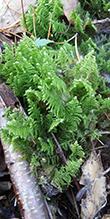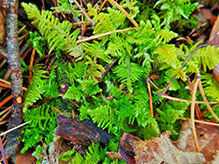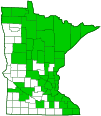fern mosses
(Thuidium spp.)
Overview • Description • Distribution • Taxonomy
Description |
Thuidium mosses are large mosses that are fern-like in appearance. The stems creep along the ground or are arched, curving up at the base. They are highly branched and are two or three times pinnately divided. Stem leaves and branch leaves are egg-shaped. The midrib (costa) ends before the leaf tip. Female sex organs (archegonia) and male sex organs (antheridia) are borne on separate plants (dioicous). The capsule is cylinder-shaped and curved, and it is held horizontally. The stalk supporting the capsule (seta) is usually smooth, rarely roughened (papillose). The two most common Thuidium species in Minnesota are Thuidium delicatulum and Thuidium recognitum. They are very difficult to tell apart in the field. Reliable identification requires examining the leaves under a compound microscope. |
Distribution |
||
|
Sources County Atlas of Minnesota Mosses (2000), Joannes A. Janssens Janssens, J.A. 2014. Noteworthy Mosses & Liverworts of Minnesota, Part II: Species Fact Sheets. Minnesota Department of Natural Resources 2014, 208 pp. |
|
| 4/4/2024 | ||
Taxonomy |
|
Kingdom |
|
Division |
|
Subdivision |
Bryophytina (moss) |
Class |
Bryopsida (joint-toothed mosses) |
Subclass |
Bryidae |
Superorder |
Hypnanae |
Order |
Hypnales (feather mosses) |
Family |
Thuidiaceae |
Subordinate Taxa |
|
Allen’s fern moss (Thuidium allenii) common tamarisk-moss (Thuidium tamariscinum) delicate fern moss (Thuidium delicatulum) eastern weft-moss (Thuidium cymbifolium) hook-leaved fern moss (Thuidium recognitum) Philbert’s fern moss (Thuidium assimile) |
|
Synonyms |
|
|
|
Common Names |
|
fern mosses thuidium mosses |
|
Glossary
Costa
On ferns: The central axis of a pinna, to which pinnules are attached. On mosses: the central axis (midvein) of a leaf. On insects: The vein on the leading edge of the forewing.
Dioicous
In bryophytes, having female sex organs (archegonia) and male sex organs (antheridia) on separate plants.
Pinnate
On a compound leaf, having the leaflets arranged on opposite sides of a common stalk. On a bryophyte, having branches evenly arranged on opposite sides of a stem.
Seta
A stiff, hair-like process on the outer surface of an organism. In Lepidoptera: A usually rigid bristle- or hair-like outgrowth used to sense touch. In mosses: The stalk supporting a spore-bearing capsule and supplying it with nutrients. Plural: setae. Adjective: setose.
Visitor Photos |
||
Share your photo of this plant. |
||
This button not working for you? |
||
Luciearl |
||
 |
||
MinnesotaSeasons.com Photos |
||
|
||
|
||

Slideshows |
|

Visitor Videos |
||
Share your video of this plant. |
||
This button not working for you? |
||
|
Other Videos |
||
|

Created: 11/10/2023 Last Updated: © MinnesotaSeasons.com. All rights reserved. |




